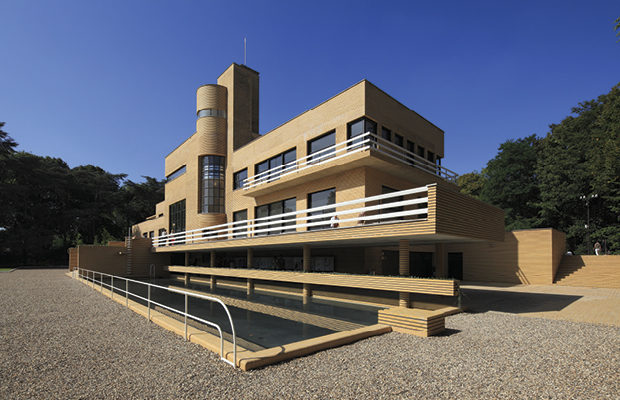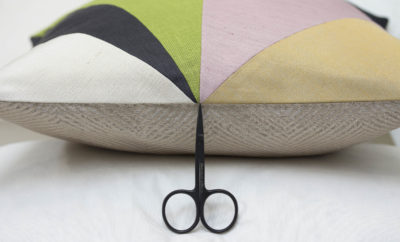 ©Robert Mallet-Stevens/©Jean-Luc Paillé–CMN
©Robert Mallet-Stevens/©Jean-Luc Paillé–CMN
Architecture
Follow the Yellow Brick Wall
Restored with state funding, Robert Mallet-Stevens’s 1932 Villa Cavrois draws visitors to the north of France
MODERNIST PILGRIMS WALKING the quiet, chic path to the Le Corbusier Foundation in Paris can find themselves suddenly hijacked, visually. Before reaching the Corbu site, to one’s left stands probably the most monumentally seductive private house in town. Built for two sculptors, the brothers Jan and Joël Martel, it was designed by Le Corbusier’s less-celebrated contemporary, architect Robert Mallet-Stevens.
Far from that eye-boggling little enclave in Paris, another Mallet-Stevens villa is becoming quite the destination. Designed in 1929 for a wealthy family enamored of all things hygienic, modern, and sportifs, the Villa Cavrois holds many lessons on evolving taste.
It took years of local grassroots efforts and pleas from such notables as Tadao Ando, Norman Foster, and Renzo Piano to save the villa. Owned for a time by a “not very scrupulous developer,” as one French authority put it, and left to crumble, its interiors had been ransacked, and shrubbery invaded the once-sleek terraces overlooking the once-perfect landscape. Then “l’État” stepped in.
After purchasing the villa and grounds in 2001, the French state spent 23 million euros to research and complete the final three years of labor-intensive restoration. Some 230 workmen were needed altogether. On the exteriors, two hundred kilometers (almost 125 miles) of seams and grout were individually painted over by hand, as per Mallet-Stevens’s original method, to accentuate the horizontal sweep of the sixty-meter-long front facade.
The villa is the antithesis of a house built on spec. It is rather the legacy of obsessive planning between a somewhat peculiar client and an exceptional architect. Paul Cavrois was a very different type of client for Mallet-Stevens. Neither Parisian nor an aristocrat, artist, or couturier, Cavrois was an industrialist. Two of his textile factories could be seen in the distance from the villa’s streamline feudal parapets. Early photos show the castle against a backdrop of chimney stacks in the gritty city of Roubaix.
France’s great mining and textile fortunes were built here, but in this northern region of the country, discretion rules and any outward display or eccentricity was frowned upon. Cavrois’s affluent neighbors in the posh little town of Croix lived in classic historicist mansions. As Peter Malacrida, an Italian decorator, commented at the time— mocking similar norms in England— one could expect the “cottagey-inglenooky-pickledoak school,” the “walnutty-Queen-Annish,” or “triumphant and unchallenged, the Hollywood- Italo-Spanish.”
Plans were underway for a lovely if unremarkable home for Cavrois, his wife, Lucie, and their seven offspring, when an encounter with Mallet-Stevens unleashed a tectonic shift
“In this part of France the Cavrois family was expected to go for a very safe ‘neo-Norman’ house,” Alexandre Pouliguen of the Centre des Monuments Nationaux, the institution in charge of the site, says with a smile. Indeed, plans were underway for a lovely if unremarkable home for Cavrois, his wife, Lucie, and their seven offspring, when an encounter with Mallet-Stevens unleashed a tectonic shift.
Cavrois and Mallet-Stevens met in 1925, at the seminal Exposition des Arts Décoratifs et Industriels Modernes in Paris, where a pavilion was dedicated to France’s northern industries, and where the architect’s designs were widely applauded. Over the next six years Cavrois would embark on ever-deepening discussions and exploratory trips with Mallet-Stevens, continuing even after construction began in 1930.
An admirer of Josef Hoffmann, of cubism, and of the De Stilj movement, Mallet-Stevens designed for industry, ocean liners, and international fairs, as well as for films by one of the sharpest observers of society in the French silent era, director Marcel L’Herbier. While designing a (sadly unfinished) villa for couturier Paul Poiret in the early 1920s, he declared concrete the material best suited for “the essentially geometric art” of modern architecture. Refusing all ornament, he considered light itself to be a material.
His use of color could be controversial. On one Mallet-Stevens-led excursion, Cavrois and his son embraced the yellowish brick of a certain town hall in Belgium—and that alkaline hue transposed to the Villa Cavrois still startles today.
Inside, rather tellingly, no art was hung on the walls. “For Mallet-Stevens the volumes were the decoration,” emphasizes Pouliguen. An exception was a relief by the Martel brothers in the children’s dining room, a rather cubist ode to tennis rackets, swimming, and the latest phonograph.
Among high-tech comforts Mallet-Stevens had promised the family was the elevator—with doors designed by Jean Prouvé. Walls were equipped with built-in art deco clocks and wireless speakers. A favorite 78 spinning on the electric phonograph (or maybe orders from Papa to go swim your fifty laps in the outdoor pool) could be heard throughout the house. “The electric clocks you see everywhere were not, as rumor has it, to exploit his workers,” Pouliguen insists. “The couple were truly fascinated by modernity.” Paul and Lucie’s bathroom, for example, manifests the efficiency and devotion to health and hygiene of an operating room.
“Cavrois spurned anything grandiose,” Pouliguen says, “You might expect the industrialist to place his office upstairs in the center, like a CEO’s throne overlooking the entrance. Instead the family chose to use that space for daily access to clean sheets and towels. This goes contrary to Corbusier’s premise that man is supposed to adapt to theory.”
“The electric clocks you see everywhere were not, as rumor has it, to exploit his workers; the couple were truly fascinated by modernity”
The Cavrois children and the neighbors were embarrassed by the whole thing. The children still in school tried hiding from classmates that the yellow castle on the hill was their home. They would be absent years later from efforts to preserve it.
German soldiers occupied the house on May 28, 1940. “The Cavrois, like many bourgeois families from the north, left with the arrival of the German army,” recounts Paul Hervé Parsy, the villa administrator, who began advocating for the house’s protection in the 1980s. “Mallet- Stevens, whose wife was Jewish, fled to non-occupied southwestern France, where they lived with very little money,” he says. “Meanwhile Le Corbusier was in Vichy cooperating with the French government. After the war Le Corbusier would go on to publish about 150 books dedicated to his own genius. Mallet-Stevens died poor and ill in 1945, having asked that his archives be destroyed.” The once-celebrated society architect fell into quasi-oblivion—along with his work, including the Villa Cavrois.
Following the death of Lucie Cavrois, the villa and its grounds were sold in 1987, and thus began years of neglect and vandalism. Designating it a historic property in 1990 against the wishes of the then-owner only accelerated willful damage. (Visitors today can comprehend the villa’s near-death experience in one room that has been preserved in all its traumatized concrete nakedness.)
The restoration process itself is the subject of a film screened for visitors to the villa; among other aspects, it records replacing the green Swedish marble in the parents’ dining room, and features interviews with an artisan resculpting exquisite cove lighting as designed by André Salomon and with the landscape architect Aline Le Coeur, describing her choices for bringing back the park—or landscape. In what had been the wine cellars, construction geeks and decorators can thank the CMN for the matériauthèque—an installation of all retrieved materials, from yanked-out plumbing to remnants of the original exotic woods, displayed like archaeological artifacts.
Streamlined white cabinets have been recreated in the high-ceilinged basilica to modernity of the pantry and kitchen. “It’s much better than the kitchens in Downton Abbey!” laughs Pouliguen, gesturing toward generous windows that would have brought in light and views of the greenery even to the help.
All the furniture was specifically designed by Mallet-Stevens for the villa, and thanks to institutional funding and generous donors, some of it is now coming home. Armchairs and tables from the main salon (living room) were purchased at Sotheby’s in New York last winter. “Thanks to original photos from 1932– 1934, I could identify his pieces at Sotheby’s last December,” Parsy says. “One American collector has given us the metallic furniture of Mr. Cavrois’ office. I’m trying to find pieces from one of the boys’ bedrooms as it was incredibly designed, but so far we have no information about the possible location.” A private collector and the gallery owner Elizabeth Royer have facilitated the return of chairs and a desk from one of the children’s study rooms. “We now have about one third of the original furniture,” Parsy says.
Long overlooked, Mallet-Stevens’s talents were reintroduced to the public through an exhibition at the Pompidou Center in 2005. However, Pouliguen observes, “With the villa we want to not just look back, we hope to surprise people, to make it a showcase for modernity today.” An opening exhibition this past spring on modern chairs was just the start, coinciding with the arrival of some of the recently returned furniture.
A happy result of the villa’s restoration has been introducing day-trippers to other nearby sites, such as La Piscine in nearby Roubaix, an indoor art deco municipal swimming pool that is now home to an exuberant mix of sculpture and paintings—many revealing decadent pleasures of the 1920s and ’30s by the likes of Dufy, Foujita, and Van Dongen.
Closer to the villa by car is a 1958 chapel by Swiss architect Hermann Baur that features vivid abstract stained glass by Alfred Manesseir embedded deep in raw concrete as well as a raw concrete confessional. There is even a 1968 Richard Neutra–designed house, the only one in France, tucked away in the same town as the villa. “We’re getting Dutch, Belgians, and Parisians, who come for ‘the combo,’” says Pouliguen. “It comes as a surprise but this region, the Nord-Pasde- Calais, offers the highest concentration of cultural institutions in the country. The perception of a rundown industrial and mining economy is giving way to a place now proud of its heritage. Ten years ago, they’d given up on serving regional specialties in cafes and restaurants. That was before the new Louvre opened not far away in Lens. Now there are start-ups in Lille and Roubaix, young people are discovering the area, and local dishes are making a comeback.”
A happy result of the villa’s restoration has been introducing day-trippers to other nearby sites
Testimony to this revitalization, the totally un-Disneyfied Villa Cavrois has already welcomed more than 160,000 visitors.











